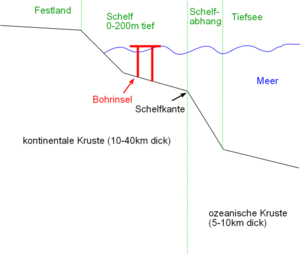Norwegian Continental Shelf
- Norwegian Continental Shelf
-

Förderaktivität auf dem norwegischen Kontinentalschelf in der Nordsee (rotbraun), im Nordmeer (hellbraun) und in der Barentssee (grün)

Der Kontinentalschelf ist der Teil des Kontinentrandes, der bei geringer Tiefe unterhalb der Meeresoberfläche liegt
Der (oder das) Norwegische Kontinentalschelf (Norwegian Continental Shelf) ist der Teil des europäischen Kontinentalrandes, der als Festlandsockel entlang der norwegischen Küste verläuft. Seine Ausdehnung entspricht ungefähr einem Drittel der Ausdehnung des gesamten europäischen Kontinentalschelfs; er erstreckt sich über ein Gebiet, das etwa vier mal so groß ist wie das norwegische Festland selbst.
Geographische Besonderheiten
Ein Teil der Nordsee liegt auf dem norwegischen Kontinentalschelf. Diese verbindet das norwegische Kontinentalschelf bei geringer Tiefe unter 200 Metern fast übergangslos mit dem britischen. Lediglich an einer Stelle, der norwegischen Rinne, erreicht sie eine Tiefe von bis zu 700 Metern.
Wirtschaftliche und politische Bedeutung
Im Schelf wird nach Erdöl und Erdgas gesucht. Der Abbau dieser Rohstoffe erfolgt hauptsächlich durch die staatliche Mineralölgesellschaft Statoil und die ebenfalls norwegische Gesellschaft Norsk Hydro und macht Norwegen mit durchschnittlich drei Millionen Barrel pro Tag nach Saudi-Arabien und Russland zum drittgrößten Erdölexporteur der Welt. Obwohl die Ölreserven im norwegischen Kontinentalschelf nur einen verhältnismäßig geringen Teil der weltweiten Ölreserven ausmachen (wenige Prozent), stellen sie dennoch etwa die Hälfte der Ölreserven Europas. Der größte Teil der Ölbohraktivität im Bereich des Schelfs findet in der Nordsee und im südlichen Teil des europäischen Nordmeers statt. Gegen Ende des 20. Jahrhunderts begann jedoch ein Ölboom Nordnorwegen zu ergreifen, nachdem von Statoil die weltweit erste Offshore-Operation in der Arktis im Snøhvit-Erdgasfeld (norwegisch „Schneeweiß“) begonnen wurde. Auf der Insel Melkøya in der Nähe von Hammerfest entsteht die größte Erdgasverflüssigungsanlage Norwegens, eines der bisher teuersten Projekte in Nordnorwegen.
Literatur
- Roald Sætre (Hrsg.): The Norwegian Coastal Current - Oceanography and Climate. Tapir Academic Press, Trondheim 2007. ISBN 978-82-519-2184-8
Weblinks
Wikimedia Foundation.
Schlagen Sie auch in anderen Wörterbüchern nach:
Norwegian continental shelf — The Norwegian continental shelf is the continental shelf over which Norway exercises sovereign rights as defined by the United Nations Convention on the Law of the Sea.[clarification needed] It is rich in petroleum and gas and it is the base of… … Wikipedia
Norwegian Sea — The Vestfjord with the mountains of the Lofoten archipelago seen from Løvøy Island in Steigen. Vågakaillen (942 m) is the taller of the two peaks in the centre of the image … Wikipedia
Norwegian Petroleum Directorate — Oljedirektoratet Agency overview Formed July 14, 1972 … Wikipedia
Norwegian government agencies — The Government agencies of Norway are state controlled organizations who act independently to carry out the policies of the Government of Norway. The Government Ministries are relatively small and merely policy making organizations, allowed to… … Wikipedia
Norwegian Current — The Norwegian Current (also known as the Norwegian Coastal Current) is a water current that flows north easterly along the Atlantic coast of Norway at depths of between 50 and 100 meters. It contrasts with the North Atlantic Current because it is … Wikipedia
Norwegian Geological Survey — Geological Survey of Norway Type Government agency Industry Geological survey Headquarters Trondheim, Norway … Wikipedia
Ross Ice Shelf — an ice barrier filling the S part of the Ross Sea. * * * World s largest body of floating ice. It lies at the head of the Ross Sea, which forms an enormous indentation in Antarctica. Its area is estimated to be about the size of France. The great … Universalium
North Sea — For other uses, see North Sea (disambiguation). North Sea Location Atlantic Ocean Coordinates … Wikipedia
Norway — /nawr way/, n. Norwegian, Norge. a kingdom in N Europe, in the W part of the Scandinavian Peninsula. 4,404,456; 124,555 sq. mi. (322,597 sq. km). Cap.: Oslo. * * * Norway Introduction Norway Background: Despite its neutrality, Norway was not able … Universalium
Deep water coral — Table coral, which can live in deep water (in this picture, it is in shallow, warm water) The habitat of deep water corals, also known as cold water corals, extends to deeper, darker parts of the oceans than tropical corals, ranging from near the … Wikipedia


